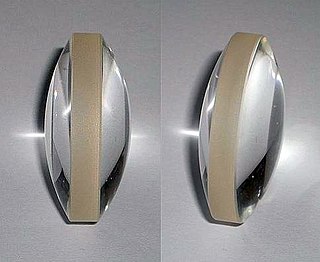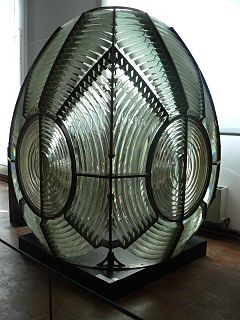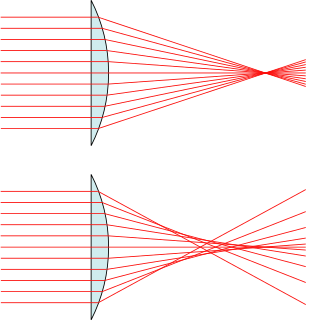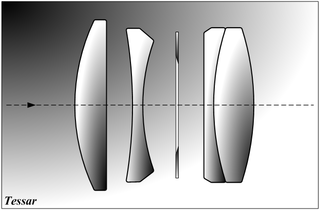
In optics, aberration is a property of optical systems, such as lenses, that causes light to be spread out over some region of space rather than focused to a point. Aberrations cause the image formed by a lens to be blurred or distorted, with the nature of the distortion depending on the type of aberration. Aberration can be defined as a departure of the performance of an optical system from the predictions of paraxial optics. In an imaging system, it occurs when light from one point of an object does not converge into a single point after transmission through the system. Aberrations occur because the simple paraxial theory is not a completely accurate model of the effect of an optical system on light, rather than due to flaws in the optical elements.

A lens is a transmissive optical device which focuses or disperses a light beam by means of refraction. A simple lens consists of a single piece of transparent material, while a compound lens consists of several simple lenses (elements), usually arranged along a common axis. Lenses are made from materials such as glass or plastic, and are ground and polished or molded to a desired shape. A lens can focus light to form an image, unlike a prism, which refracts light without focusing. Devices that similarly focus or disperse waves and radiation other than visible light are also called lenses, such as microwave lenses, electron lenses, acoustic lenses, or explosive lenses.

A Fresnel lens is a type of composite compact lens developed by the French physicist Augustin-Jean Fresnel (1788–1827) for use in lighthouses. It has been called "the invention that saved a million ships."

In optics, spherical aberration (SA) is a type of aberration found in optical systems that have elements with spherical surfaces. Lenses and curved mirrors are prime examples, because this shape is easier to manufacture. Light rays that strike a spherical surface off-centre are refracted or reflected more or less than those that strike close to the centre. This deviation reduces the quality of images produced by optical systems.

The Tessar is a photographic lens design conceived by the German physicist Paul Rudolph in 1902 while he worked at the Zeiss optical company and patented by Zeiss in Germany; the lens type is usually known as the Zeiss Tessar.
Optics is the branch of physics which involves the behavior and properties of light, including its interactions with matter and the construction of instruments that use or detect it. Optics usually describes the behavior of visible, ultraviolet, and infrared light. Because light is an electromagnetic wave, other forms of electromagnetic radiation such as X-rays, microwaves, and radio waves exhibit similar properties.

A stereoscope is a device for viewing a stereoscopic pair of separate images, depicting left-eye and right-eye views of the same scene, as a single three-dimensional image.

A screen magnifier is software that interfaces with a computer's graphical output to present enlarged screen content. By enlarging part of a screen, people with visual impairments can better see words and images. This type of assistive technology is useful for people with some functional vision; people with visual impairments and little or no functional vision usually use a screen reader.

Magnification is the process of enlarging the apparent size, not physical size, of something. This enlargement is quantified by a calculated number also called "magnification". When this number is less than one, it refers to a reduction in size, sometimes called minification or de-magnification.

A magnifying glass is a convex lens that is used to produce a magnified image of an object. The lens is usually mounted in a frame with a handle. A magnifying glass can be used to focus light, such as to concentrate the sun's radiation to create a hot spot at the focus for fire starting.
In optics, a simple lens or singlet lens is a lens consisting of a single simple element. Typical examples include a magnifying glass or a lens in a pair of simple reading glasses.

A catadioptric optical system is one where refraction and reflection are combined in an optical system, usually via lenses (dioptrics) and curved mirrors (catoptrics). Catadioptric combinations are used in focusing systems such as searchlights, headlamps, early lighthouse focusing systems, optical telescopes, microscopes, and telephoto lenses. Other optical systems that use lenses and mirrors are also referred to as "catadioptric", such as surveillance catadioptric sensors.

A reading stone is an approximately hemispherical lens that can be placed on top of text to magnify the letters so that people with presbyopia can read it more easily. Reading stones were among the earliest common uses of lenses.

Video magnifiers are electronic devices that use a camera and a display screen to perform digital magnification of printed materials. The display screen is usually LCD or a similar flat-screen technology, and the device usually includes a lamp to illuminate the source material. Video magnifiers are designed to be mostly used by people with low vision that cannot be helped using a conventional magnifying glass.
The design of photographic lenses for use in still or cine cameras is intended to produce a lens that yields the most acceptable rendition of the subject being photographed within a range of constraints that include cost, weight and materials. For many other optical devices such as telescopes, microscopes and theodolites where the visual image is observed but often not recorded the design can often be significantly simpler than is the case in a camera where every image is captured on film or image sensor and can be subject to detailed scrutiny at a later stage. Photographic lenses also include those used in enlargers and projectors.

A red dot sight is a common classification for a type of non-magnifying reflector sight for firearms, and other devices that require aiming, that gives the user a point of aim in the form of an illuminated red dot. A standard design uses a red light-emitting diode (LED) at the focus of collimating optics which generates a dot-style illuminated reticle that stays in alignment with the weapon the sight is attached to, regardless of eye position. They are considered to be fast-acquisition and easy-to-use gun sights for civilian target shooting, hunting, or in police and military applications. Aside from firearm applications, they are also used on cameras and telescopes. On cameras they are used to photograph flying aircraft, birds in flight, and other distant, quickly moving subjects. Telescopes have a narrow field of view and therefore are often equipped with a secondary "finder scope" such as a red dot sight.

A condenser is an optical lens which renders a divergent beam from a point source into a parallel or converging beam to illuminate an object.
A microfilm reader is a device used in projecting and magnifying images stored in microform to readable proportions. Microform includes flat film, microfilm, aperture cards, microfiche, and ultra fiche. Using open reels or cassettes, microfilm is often used as a way to store many documents in a small space. It has become increasingly prevalent in the development of films, as well as storage of archived newspapers. With the invention of microfilm, microfilm readers soon developed. With the increasing popularity of computers, microform has decreased in use. However, many library archives still remain in microform.

Shooting glasses are specialized corrective glasses for use in shooting and are used almost exclusively in sport shooting competitions. Like other glasses, they are worn in front of the eyes to compensate for the shooter's ametropia with optical lenses.














